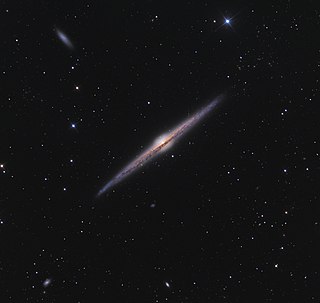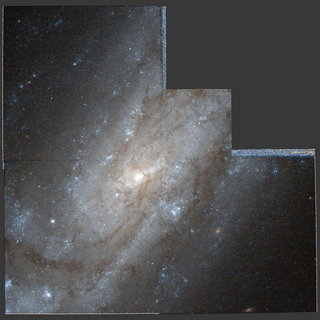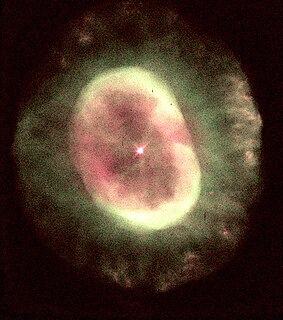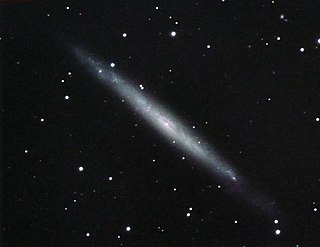
A radio telescope is a specialized antenna and radio receiver used to detect radio waves from astronomical radio sources in the sky. Radio telescopes are the main observing instrument used in radio astronomy, which studies the radio frequency portion of the electromagnetic spectrum emitted by astronomical objects, just as optical telescopes are the main observing instrument used in traditional optical astronomy which studies the light wave portion of the spectrum coming from astronomical objects. Unlike optical telescopes, radio telescopes can be used in the daytime as well as at night.

The Galaxy Evolution Explorer (GALEX) was an orbiting ultraviolet space telescope which was launched on 28 April 2003 and operated until early 2012.

The Apache Point Observatory is an astronomical observatory located in the Sacramento Mountains in Sunspot, New Mexico, United States, approximately 18 miles (29 km) south of Cloudcroft. The observatory is operated by New Mexico State University (NMSU) and owned by the Astrophysical Research Consortium (ARC). Access to the telescopes and buildings is private and restricted.

The Sloan Digital Sky Survey or SDSS is a major multi-spectral imaging and spectroscopic redshift survey using a dedicated 2.5-m wide-angle optical telescope at Apache Point Observatory in New Mexico, United States. The project was named after the Alfred P. Sloan Foundation, which contributed significant funding.
The Digitized Sky Survey (DSS) is a digitized version of several photographic astronomical surveys of the night sky, produced by the Space Telescope Science Institute between 1983 and 2006.

An astronomical survey is a general map or image of a region of the sky that lacks a specific observational target. Alternatively, an astronomical survey may comprise a set of many images or spectra of objects that share a common type or feature. Surveys are often restricted to one band of the electromagnetic spectrum due to instrumental limitations, although multiwavelength surveys can be made by using multiple detectors, each sensitive to a different bandwidth.

NGC 4565 is an edge-on spiral galaxy about 30 to 50 million light-years away in the constellation Coma Berenices. It lies close to the North Galactic Pole and has a visual magnitude of approximately 10. It is known as the Needle Galaxy for its narrow profile. First recorded in 1785 by William Herschel, it is a prominent example of an edge-on spiral galaxy.

Arp 220 is the result of a collision between two galaxies which are now in the process of merging. It is the 220th object in Halton Arp's Atlas of Peculiar Galaxies.

NGC 1073 is a barred spiral galaxy in the constellation Cetus. The galaxy is estimated to be about 55 million light years from Earth, possess a disk spanning an estimated 80,000 light years in diameter, and likely contains a type of active core, called an HII nucleus.

NGC 4559 is an intermediate spiral galaxy with a weak inner ring structure in the constellation Coma Berenices. Distance estimates for NGC 4559 range from about 28 million light-years to 31 million light-years, averaging about 29 million light-years.

NGC 7662 is a planetary nebula located in the constellation Andromeda.
Sky-Map.org is a wiki and interactive sky map that covers more than half a billion celestial objects. Users can view the whole star sky at once and zoom in to view areas in greater detail. WikiSky includes many stars, galaxies, constellations, and planets, but it is still in development. Users can also edit information about different stars by writing articles, adding Internet links, uploading images, or create a special interest group for a specific task. The website, although still available for users to visit, has not shown much activity since 2010.

NGC 4244, also known as Caldwell 26, is an edge-on loose spiral galaxy in the constellation Canes Venatici, and is part of the M94 Group or Canes Venatici I Group, a galaxy group relatively close to the Local Group containing the Milky Way. In the sky, it is located near the yellow naked-eye star, Beta Canum Venaticorum, but also near the barred spiral galaxy NGC 4151 and irregular galaxy NGC 4214.

A Pea galaxy, also referred to as a Pea or Green Pea, might be a type of luminous blue compact galaxy that is undergoing very high rates of star formation. Pea galaxies are so-named because of their small size and greenish appearance in the images taken by the Sloan Digital Sky Survey (SDSS).

NGC 5985 is a spiral galaxy located in the northern constellation Draco. NGC 5985 was discovered by William Herschel in 1788.
Christy A. Tremonti is an observational astronomer on the faculty at the University of Wisconsin–Madison. She was a 2005 Hubble Fellow while at the University of Arizona. She received her PhD from Johns Hopkins University in 2003 and her BS from Colgate University in 1994. She completed her dissertation, "The physical properties of low redshift star forming galaxies: Insights from the space-UV and 20,000 SDSS spectra", under the supervision of Timothy M. Heckman.
Constance "Connie" M. Rockosi is a chair of the Astronomy and Astrophysics Department at the University of California, Santa Cruz. She earned her PhD in 2001 and helped design the camera for the telescope that was used as part of the initial Sloan Digital Sky Survey (SDSS). She also was in charge of the SDSS-III domain for the Sloan Extension for Galactic Understanding and Exploration (SEGUE) project and is the primary investigator on SEGUE-II. Her focuses involve the study of the Milky Way galaxy, with a focus on the evolution that it took to reach its current state. She believes that through the study of our own galaxy, and the way that it formed, we can understand the formation of other galaxies during the Redshift phase of their creation. The purpose of her research is to explore the effects of major accretion events in the formation of the Milky Way, to understand why certain properties of the galaxy exist as they do.

Howard J. Brewington is an American comet discoverer and former professional telescope operator of the Sloan Digital Sky Survey.
The ALFALFA research project is located at the Arecibo Observatory and started on February 4th 2005. It is still ongoing. The name is the abbreviation of Arecibo Legacy Fast ALFA. ALFA is the abbreviation of Arecibo L-Band Feed Array.













